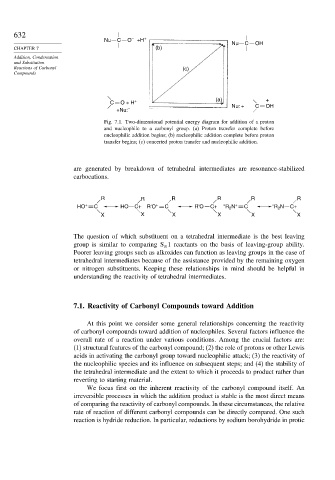Page 650 - Advanced Organic Chemistry Part A - Structure and Mechanisms, 5th ed (2007) - Carey _ Sundberg
P. 650
632
Nu C O – +H +
Nu C OH
CHAPTER 7 (b)
Addition, Condensation
and Substitution
Reactions of Carbonyl (c)
Compounds
C O + H + (a) Nu: + C +
OH
+Nu: –
Fig. 7.1. Two-dimensional potential energy diagram for addition of a proton
and nucleophile to a carbonyl group. (a) Proton transfer complete before
nucleophilic addition begins; (b) nucleophilic addition complete before proton
transfer begins; (c) concerted proton transfer and nucleophilic addition.
are generated by breakdown of tetrahedral intermediates are resonance-stabilized
carbocations.
R R R R R R
HO + C HO C+ R'O + C R'O C+ ''R N + C ''R 2 N C+
2
X X X X X X
The question of which substituent on a tetrahedral intermediate is the best leaving
group is similar to comparing S 1 reactants on the basis of leaving-group ability.
N
Poorer leaving groups such as alkoxides can function as leaving groups in the case of
tetrahedral intermediates because of the assistance provided by the remaining oxygen
or nitrogen substituents. Keeping these relationships in mind should be helpful in
understanding the reactivity of tetrahedral intermediates.
7.1. Reactivity of Carbonyl Compounds toward Addition
At this point we consider some general relationships concerning the reactivity
of carbonyl compounds toward addition of nucleophiles. Several factors influence the
overall rate of a reaction under various conditions. Among the crucial factors are:
(1) structural features of the carbonyl compound; (2) the role of protons or other Lewis
acids in activating the carbonyl group toward nucleophilic attack; (3) the reactivity of
the nucleophilic species and its influence on subsequent steps; and (4) the stability of
the tetrahedral intermediate and the extent to which it proceeds to product rather than
reverting to starting material.
We focus first on the inherent reactivity of the carbonyl compound itself. An
irreversible processes in which the addition product is stable is the most direct means
of comparing the reactivity of carbonyl compounds. In these circumstances, the relative
rate of reaction of different carbonyl compounds can be directly compared. One such
reaction is hydride reduction. In particular, reductions by sodium borohydride in protic

